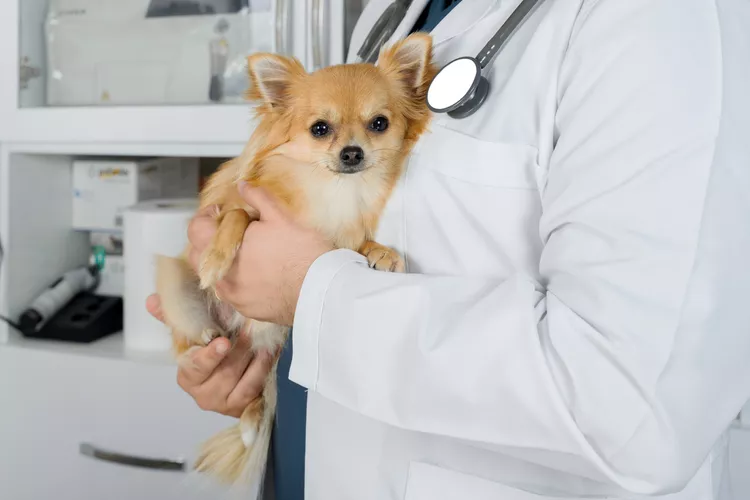Legg-Calve-Perthes Disease in Dogs

Legg-Calve-Perthes disease (LCPD) is an uncommon orthopedic disorder that can occur in dogs and humans. This congenital disease causes degeneration of the hip joint in young dogs, primarily small breeds. Animals affected by Legg-Calve-Perthes disease will ultimately need surgical treatment to maintain the use of the affected limb.
What is Legg-Calve-Perthes Disease?
Legg-Calve-Perthes disease is an uncommon degenerative disease of the hip joint that begins with inadequate blood supply to the head of the femur. The femoral head is the "ball" part of the hip joint that sits in the pelvis and facilitates motion in the hip and rear limb.
Without the necessary blood supply, the bony tissues begin to disintegrate, leaving the femoral head deformed. The cartilage that once acted as a cushion between the ball and socket can no longer remain in place. The result is an ill-fitting joint that becomes very painful when moving the affected limb.
The name "Legg-Calve-Perthes" derives from the three separate orthopedic surgeons who discovered the disease in children in the early 20th century.
Symptoms of Legg-Calve-Perthes Disease in Dogs
The symptoms of LCPD may be subtle at first but will progressively become more apparent as the degeneration worsens.
The signs of Legg-Calve-Perthes disease often begin with mild lameness that gets steadily worse over weeks to months. As the disease progresses, pain and stiffness will become more noticeable and muscle atrophy will develop. The dog will eventually stop bearing any weight on the affected limb due to pain and weakness. The typical onset of signs is between five and eight months of age.
What Causes Legg-Calve-Perthes Disease in Dogs?
Legg-Calve-Perthes is is typically a hereditary disease believed to be caused by:
- A lack of adequate blood supply to the femur (thigh bone)
The lack of blood flow causes necrosis of the femoral head, leading to the gradual disintegration of bone and cartilage in the hip joint.
Legg-Calve-Perthes primarily affects small breed dogs. Yorkshire Terriers are most often affected, but several other types of small dog breeds can develop the disease. In rare cases, the disease can be induced by an injury.
How Vets Diagnose Legg-Calve-Perthes Disease in Dogs
Similar signs may occur in dogs with other orthopedic conditions, such as hip dysplasia, so a definitive diagnosis is critical to determining the appropriate course of treatment. Your veterinarian will make a diagnosis based on history, examination, and x-rays.
If your dog has worsening lameness or any other signs of illness, schedule a veterinary check-up. The earlier a diagnosis is made, the better the chance of effective treatment.
How to Treat Legg-Calve-Perthes Disease in Dogs
In mild cases of Legg-Calve-Perthes disease, vets may treat conservatively with rest and pain medications such as anti-inflammatory drugs. Conservative therapy can help manage the lameness, but it will not stop the progression of the disease. If the signs do not progress, the dog may be able to live comfortably for years. It's important to keep the dog lean as excess weight will put too much strain on the joint.
Ultimately, surgery is the best treatment for Legg-Calve-Perthes disease. Your veterinarian will perform a femoral head and neck excision. This involves the removal of the disintegrating bone on the "ball" portion of the joint.
Prognosis for Dogs with Legg-Calve-Perthes Disease
After surgery, rehabilitation therapy is necessary to help rebuild muscles that create a kind of "false joint" where the diseased bone used to be. Dogs that had early disease changes or mild signs may recover quickly. Dogs with muscle atrophy may need more time to rebuild muscle mass. Fortunately, in time, most dogs will make full recoveries and go on to live normal lives.
How to Prevent Legg-Calve-Perthes Disease
Aside from avoiding traumatic injuries, there is not much you can do to prevent the disease from developing in a dog you already have. However, you can avoid putting your dog through the worst of the symptoms by going to the vet soon after signs appear.
It is important not to breed a dog with Legg-Calve-Perthes disease to avoid passing on the gene. Instead, dogs with Legg-Calve-Perthes disease should be spayed or neutered.
Responsible breeders often test the hips of dog breeds predisposed to Legg-Calve-Perthes disease before breeding them. Testing can be done by submitting radiographs to the Orthopedic Foundation for Animals (OFA) where they can be reviewed for signs of LCPD and hip dysplasia.
If you are buying a small dog breed from a breeder, ask if the parents' hips have been examined by a vet, ideally via the OFA.